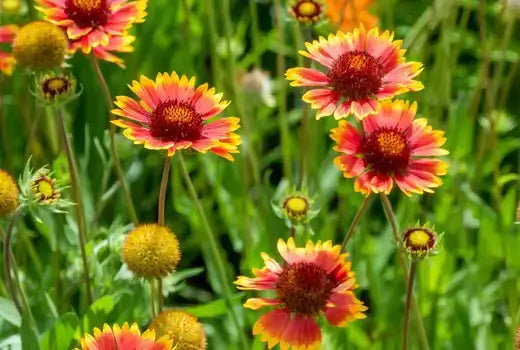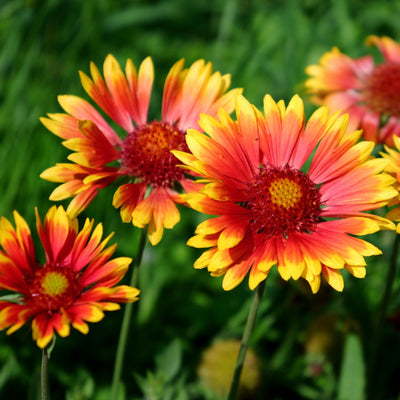Long Blooming Perennial Favorites
As the vibrant colors of summer fade into memory and the days grow shorter, many gardeners mourn the approaching end of the growing season. However, autumn doesn't have to signal the end of beautiful blooms in your garden. Several long-blooming perennials continue to grace your outdoor space with colorful flowers well into the fall.
Top Long Blooming Season Perennials You Should Plant
This article will explore four perennial favorites - Purple Coneflower, Primrose, Butterfly Weed, and Blanket Flower - known for their extended blooming season and ability to add a touch of autumnal charm to your garden.
Purple Coneflower (Echinacea purpurea) Purple Coneflower, scientifically known as Echinacea purpurea, is a beloved perennial synonymous with summer gardens. However, many gardeners must realize that this beautiful and hardy plant can shine in autumn.
Vibrant Colored Long Blooming Perennial Favorites
Purple Coneflower boasts a long blooming season that typically begins in late spring and continues through the summer and fall. Characteristics: Purple Coneflower features striking daisy-like flowers with prominent, cone-shaped centers. The petals are typically a vibrant purple, but cultivars offer variations in color, including pink, white, and even orange. Its sturdy stems can reach heights of 2 to 4 feet, making it an excellent choice for the middle or back of a garden border. This drought-tolerant plant thrives in full sun to partial shade, making it versatile in various garden settings. Autumn Appeal: Purple Coneflower continues to bloom profusely as the days grow shorter and temperatures drop. The rich purple and pink hues of its petals provide a stunning contrast to the changing colors of the autumn foliage. The late-season nectar-rich blooms also attract pollinators, making them an excellent choice for supporting local wildlife during fall.
Evening Primrose is a Unique Long Blooming Perennial Favorite
Evening Primrose Primroses, members of the Primula genus, are charming perennials celebrated for their early spring blooms. While they are primarily known for their springtime splendor, some varieties of primroses can extend their blooming season well into the autumn, making them an unexpected and delightful addition to your fall garden. Characteristics: Primroses feature delicate, cup-shaped flowers in various colors, including yellow, pink, purple, and white. They are typically low-growing plants suitable for ground covers, edging, or containers. Primroses thrive in moist, well-drained soil and prefer partial shade or dappled sunlight.
Autumn Appeal: Some primrose varieties, such as the Japanese primrose (Primula japonica) and certain hybrids, produce a second flush of blooms in the cooler temperatures of late summer and early fall. The soft pastel primrose colors gently contrast the bolder shades of autumn, adding a touch of elegance to the garden. Their extended blooming season makes them a valuable choice for bridging the gap between summer's end and winter's onset.
Butterfly Weed - A Long Blooming Perennial Monarch Favorite
Butterfly Weed (Asclepias tuberosa) Butterfly Weed scientifically known as Asclepias tuberosa, is a perennial plant famous for supporting pollinators, especially monarch butterflies. While its peak bloom time is during the summer, Butterfly Weed continues to attract attention well into the fall months. Characteristics: This plant produces clusters of bright, fiery orange or yellow flowers atop sturdy stems.
It is a native plant in North America and is vital in supporting monarch butterflies during migration. Butterfly Weed is drought-tolerant and thrives in full sun, making it an excellent choice for xeriscape gardens. Autumn Appeal: The vibrant, warm colors of Butterfly Weed flowers add a pop of color to the garden as the days cool. As other summer blooms fade, this perennial remains a reliable nectar source for late-season butterflies, bees, and other pollinators. Its seed pods, which split open to reveal seeds equipped with silky parachutes, add unique visual interest to the fall garden.
Last But Certainly Not Least In The Long Blooming Cycle Perennials
Blanket Flower (Gaillardia) Blanket Flower, scientifically known as Gaillardia, is a perennial favorite cherished for its bright and cheerful blooms. These flowers are often associated with summer, but many Gaillardia varieties continue to flower into the autumn, making them an excellent addition to your fall garden. Characteristics: Blanket Flowers feature daisy-like blooms with red or yellow petals and prominent brown or dark centers. They are typically compact, bushy plants that grow to a height of 1 to 2 feet.
Blanket Flowers are easy to grow and thrive in well-drained soil and full sun. Autumn Appeal: The warm and sunny colors of Blanket Flower, including shades of red, orange, and yellow, evoke the cozy and inviting feeling of autumn. The extended blooming season of this perennial ensures that your garden remains vibrant well into the fall. Blanket Flowers are also excellent cut flowers, making them great for autumn floral arrangements. Conclusion While many gardeners associate autumn with the end of the growing season, assuming that vibrant blooms must halt is a mistake.
Purple Coneflower Is a Perennial Favorite
The perennials discussed in this article - Purple Coneflower, Primrose, Butterfly Weed, and Blanket Flower - defy the conventional wisdom of a summer-exclusive garden. These long-blooming favorites continue to shine in autumn, providing your garden with various colors and attracting pollinators even as the days grow shorter and more relaxed. With their unique characteristics and autumn appeal, these perennials offer visual beauty and ecological benefits.
When nectar sources become scarcer, they support local wildlife, including butterflies and bees. Their extended blooming season also helps bridge the transition from summer to winter, ensuring your garden remains a source of joy and inspiration throughout the fall. So, if you want to extend the beauty of your garden and embrace the colors of autumn, consider planting Purple Coneflower, Primrose, Butterfly Weed, and Blanket Flower. Their resilience and charm will prove that fall gardening can be just as delightful as any other season, filling your outdoor space with warmth, color, and life.


